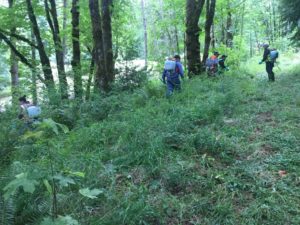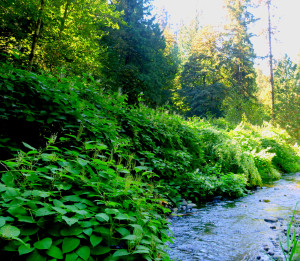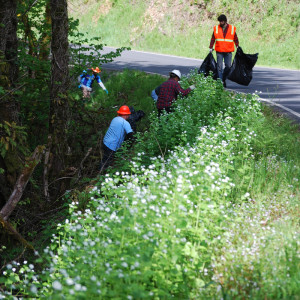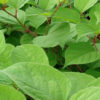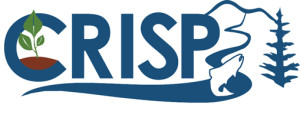 The Problem of Weeds on the Clackamas River
The Problem of Weeds on the Clackamas River
The Clackamas is a remarkably scenic river and a beautiful place to live, work, and recreate. The lower half of the river is home to many private residences, farms, public parks, quarries, golf courses, and natural areas. Unfortunately, and partly as a natural result of all this activity, it is also home to many invasive weeds.
Invasive weeds can cost landowners and managers a lot of money to control. They can degrade pastures and agricultural land. Some weeds can clog shorelines and smaller waterways, and some are even toxic. Furthermore, many of these weeds can spread upland or downstream, causing problems in other areas.

The CRISP hosted a 4-County Cooperative Weed Management Area field day, highlighting collaborative weed control and restoration along the Clackamas River. Photo by Samuel Leininger, CSWCD
Partner Collaboration
Many of our partners are doing great work along the Clackamas River. In particular, there has been a lot of work between Carver and Milo McIver State Park in Estacada. For example, the Clackamas River Basin Council has been removing weeds and planting native shrubs and trees at many streamside sites through their Shade Our Streams Program. Metro has many active restoration and weed control activities at multiple properties they manage. Both Oregon State Parks and Clackamas County also have multiple parks in this area where land managers control invasive weeds. The WeedWise program also controls high-priority weeds at many private and public sites along the Clackamas.
Despite all this great work, we needed shared strategies, increased coordination, and a way to seek sustainable sources of funding. The Clackamas River Invasive Species Partnership (CRISP) has provided these things, allowing us to accomplish more weed control. CRISP partners submit weed control project ideas and then meet to discuss and prioritize the projects. While we carry out projects throughout the whole watershed, the area between Carver and Milo McIver State Park is our key focus area. We highlight 3 focus area projects below.
Milo McIver State Park (and surrounding areas) Project
Milo McIver State Park is an important area for both recreation and wildlife habitat. Aside from a few satellite weed patches, it also has the most upstream population of both garlic mustard and false brome. Because of its location on the River, and its importance as a recreation destination, it has a high potential to be a source for the spread of these weeds to other areas. For example, a camper, hiker, or disc golfer can come to the park from out of the area, get a bit of mud (with seeds!) on their boots or wheels, and then track it back home or to another park.
As a result of CRISP, Oregon Parks and Recreation Department has been able to go after these weeds more effectively and aggressively. Furthermore, the increased coordination has brought attention to the area and the WeedWise program has controlled these weeds on neighboring properties. Furthermore, the WeedWise program has been able to control two Oregon Class A noxious weeds, giant hogweed and oblong spurge, on neighboring properties. This prevents the weeds from entering the park, thus reducing the chances they will spread elsewhere.
Across the river, there is further collaboration to control several high priority weeds. Portland General Electric, Columbia Land Trust, the Clackamas River Basin Council, and the WeedWise program are working together to control garlic mustard, knotweed, policeman’s helmet, false brome, and spurge laurel.
Knotweed Project
Originally from Asia, but introduced to Europe and North America in the 1800s, invasive knotweeds are aggressively invading streams, rivers, and other landscapes. Many people who live on the Clackamas or its tributaries are all too familiar with this weed. While all of the CRISP partners would love to completely eradicate it, there is simply too much for anyone to control at a large scale. The good news is that CRISP has increased both coordination and resources to allow us to control more knotweed than we could without the partnership.
In 2017, 2018, and 2019, after coordination with CRISP partners, the WeedWise team tackled knotweed along the Clackamas upstream from where Richardson Creek flows into the Clackamas (near the junction of Highway 224 and Tong Rd). The WeedWise program was also able to survey and treat knotweed along upper/middle Clear Creek, Eagle Creek, Dubois Creek, North Fork Deep Creek, and other smaller streams that flow into the Clackamas. The surveys are important for us to understand where the knotweed is coming from and how to prioritize our control efforts. We are also coordinating work with the Clackamas River Basin Council to control knotweed along Deep Creek. In the future, we hope to expand this work to other Clackamas tributaries and further downstream on the Clackamas.
Garlic Mustard Project
Garlic mustard is another serious invasive plant in North America. Highly adaptable, garlic mustard is difficult to control, spreads through copious seed production, and forms dense stands that out-compete native vegetation. Eradicating garlic mustard is a long process that can take years, even decades, before eradication is even possible. Thankfully, garlic mustard has not spread along the Clackamas as badly as knotweed, and CRISP partners have been able to make control efforts at most of the known populations each year. Part of the problem we face is that we don’t know about all the garlic mustard patches or don’t have access to them.
CRISP has helped the WeedWise program to reach out to more property owners. We’ve sent letters to inform people about our program and our efforts to control invasive weeds. Currently, there are about 510 landowners in the Clackamas watershed that are signed on to participate. CRISP has also supported WeedWise efforts to survey those properties. In addition to these plant surveys, WeedWise and Metro collaborated to survey some of the islands in the Clackamas River. Afterward, we worked with restoration contractors to control the weeds we found, thus preventing them from spreading downstream.

